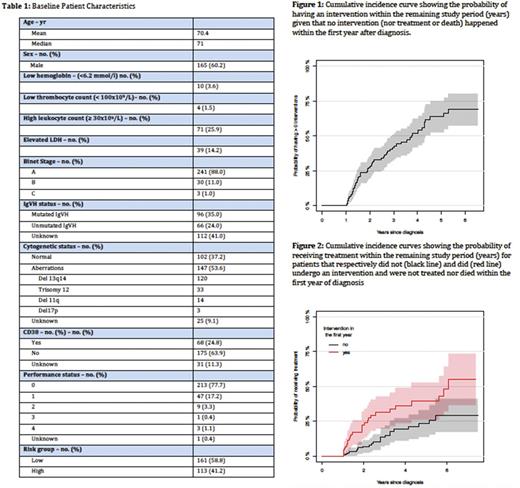Abstract
The clinical course of chronic lymphocytic leukemia (CLL) is highly variable. Most patients are diagnosed at an early, asymptomatic disease stage without immediate need of treatment, and therefore initially managed by "watch and wait" (WAW). The aim of this study was to investigate the value of routine follow-up visits for CLL patients managed by WAW.
A total of 305 patients with newly diagnosed CLL were identified during the surveyed time period (2007-2014). Thirty-one patients were excluded due to treatment-initiation within 90 days of diagnosis, which left a total of 274 (90%) patients, initially managed by WAW, for further analyses (Table 1). Each patient underwent allocation into a low- or high-risk CLL group. The low-risk group (Binet stage A, mutated IgVH, and normal cytogenetics/13q-) constituted 59% of patients, while the high-risk group (Binet stage B/C, and/or unmutated IgVH, and/or trisomy 12/11q-/17p) included the remaining 41% of patients.
The total number of follow-up visits conducted during the study period was 2,335 and detailed information from each was collected, including clinical and laboratory findings (CLL-symptoms, physical examination findings, and blood values: hemoglobin, LDH, thrombocyte- and leukocyte count) and interventions . Interventions occurred at 388 (17%) follow-up visits and were defined as follows (including overall frequency): biopsy (lymph node or bone marrow, (1%)), image diagnostics (X-ray (0.4%), ultrasound (1%), or CT-scan (2%)), additional blood tests (3%), CLL-related therapy (2%), increased frequency of blood tests (5%) and increased frequency of follow-up visits (9%).
Interventions were prompted by the following clinical and laboratory findings (including proportions and overall frequency): symptoms (31 (8%)), physical findings (15 (4%)), abnormal blood values (87 (22%), symptoms & physical findings (8 (2%)), symptoms & abnormal blood values (101 (26%)), physical findings & abnormal blood values (59 (15%)), symptoms, physical findings, & abnormal blood values (51 (13%)), and no obvious reported symptoms, physical findings, & abnormal blood values present (36 (9%)).
The median follow-up time was 3.1 years. The mean interval between outpatient routine follow-up visits was 123 days (~3.9 months), with observed difference between high-risk (109 days (~3.3 months)) and low-risk patients (134 days (~4.3 months), P= 0.039). We analyzed the time from diagnosis to first intervention, and found a 38% risk of having first intervention during the initial year after diagnosis, 16% during the second year, 8% during the third year, and 15% between 4 and 6 years after diagnosis. Within the study period, 76 (28%) patients initiated CLL-directed treatment, with high-risk patients having a significantly higher risk of receiving treatment (P < 0.001), whereas 63 (23%) patients died (27 deaths occurred before CLL treatment).
The risk of undergoing at least one intervention within 2 years of diagnosis was 54% (95% CI: 47-60), while the risk of receiving treatment within 2 years was 21% (95% CI: 16-27). Given that patients did not undergo an intervention nor receive treatment within the first year after diagnosis, the risk of receiving an intervention within the following 2 years dropped to 42% (95% CI: 33-51, Figure 1), while the risk of receiving treatment in that time frame was 14% (95% CI: 7-20). The corresponding risk of treatment within the following 2 years, for patients undergoing one or more interventions during the first year, was 31% (95% CI: 20-43, P= 0.001 for comparison with no intervention, Figure 2). After adjustment for risk group, using a stratified version of Gray's test, the risk of receiving treatment remained higher in the group that had one or more intervention within the first year after diagnosis (P= 0.048).
In summary, this study demonstrates that routine follow-up visits in CLL rarely lead to clinical interventions. Only 17% of 2,335 visits led to an intervention with as little as 3% of routine visits resulting in CLL-directed treatment. Furthermore, patients that did not undergo interventions in the first year after CLL-diagnosis were less likely to receive CLL treatment in near future, suggesting that less intensive disease surveillance strategies can be pursued for this group.
El-Galaly: Roche: Other: Travel funding; Takeda: Other: Travel funding.
Author notes
Asterisk with author names denotes non-ASH members.


This feature is available to Subscribers Only
Sign In or Create an Account Close Modal